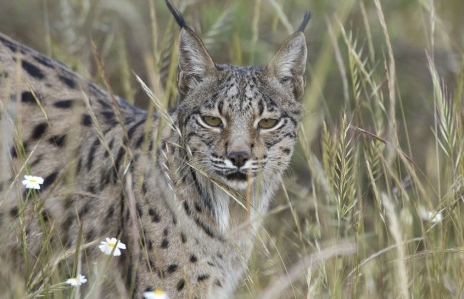
The Iberian Lynx is one of Spain's most magical creatures
What do you think of when you imagine a Spanish holiday? Is it sun-kissed beaches in the Balearics? Glitzy yachts on the Med? Palm tree-fringed hotels offering all-inclusive poolside pleasures? Or even cheap and cheerful English cafés serving all-day breakfasts to hungover stag parties?
All true, of course. But this is just the obvious face of Spanish tourism. There are plenty of other faces of Spain, too. There are the mountains, the ancient cities, the forests, the art galleries, the bullfights, the flamenco bars, the tapas… but you know all this.
What you may not know is that there is a third way. An off-the-beaten track kind of way. So set aside your images of flamenco dresses, jugs of sangria and huge pans of paella for a moment, and think instead of wolves, lynx and bears…
Now, these three beasts are not normally associated with Spain. Wolves, for me at least, evoke images of the snowy wilds of Canada. Bears make me think of the Siberian tundra or American national parks, while lynx make me think of Africa.
But all are native to Spain, and for a Brit – where the most exotically dangerous animal is a hungry seagull – that is pretty mindblowing. Most corners of Spain are just two hours away from the UK by plane, yet the country’s wilderness feels like it is from a different continent altogether.
It almost is. The very southern tip of Spain, where the country’s handful of wild lynx are thought to reside, is only a few miles from north Africa. And even in the north, where the Pyrenees mountains act as a pretty insurmountable buffer between France, Spain’s countryside has a rugged, stark wildness to it that is extremely rare in Europe.
Despite the country’s size and relative emptiness, and thanks to years of EU investment in Spain’s roads, the country is actually pretty easy to get around. But while most people stick to the Mediterranean coast, Madrid, Barcelona and the stunning cities of Andalucía, it doesn’t take long to take a trip into the unknown…
For wolf-watching: head to the Sierra de la Culebra, in the northwest of Spain. Just a few miles from the border with Portugal, this rolling, rugged terrain is thought to be home to hundreds of wild wolves. Folklore has always treated wolves as something of an evil enemy, but in recent years wolf tourism has brought in some much-needed income for the locals.
To spot a bear: head to the Cantabrian Mountains in the far central north of Spain. These brown bears are thought to number around one hundred, but they are so elusive and live in such wild, impenetrable terrain that this is only an estimate. You are extremely unlikely to actually see a bear in Cantabria, but just knowing that they are there is magic enough…
For lynx lovers: Stick to Andalucía. There are just two strongholds of the Iberian lynx in Spain, both in Andalucía. The famous Doñana National Park has an estimated 30 adults, and there are around 110 in the Sierra Morena, a little farther north. This beautiful big cat is extremely endangered, but conservation efforts have been stringent and successful in recent years, and numbers are on the rise again.
So there you have it – Spain is much more than beaches, sunshine, flamenco and tapas. It has a wild edge to it that often gets overlooked. So if you fancy taking a walk on the wild side in 2013, not only can you stay in Europe, you can even be back on your sun lounger after a day in the wilderness… and where else can you say that?
 en
en



 Vlaams-Nederlands
Vlaams-Nederlands
0 Comments
Leave a Comment
DISCLAIMER
The opinions and comments expressed by contributors to this Blog are theirs alone and do not necessarily reflect the views of VIVA Homes Under the Sun Ltd, any of its associated companies, or employees; nor is VIVA to be held responsible or accountable for the accuracy of any of the information supplied.
Have you got something to say?